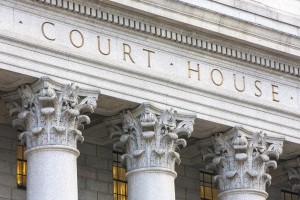Often our clients, even the most seasoned of them, get frustrated with the civil court process. It’s as if the counsel they retained before coming to our firm believed that allowing the client to “peek behind the curtain” by fully understanding the process would expose coveted legal-realm secrets. In our experience, however, the attorney-client relationship functions better when clients understand the whole of the process and know what to expect.
This summary provides only the skeletal framework of a complex and dynamic system. The process varies depending on the specific type of case and issues involved, as well as on the court where the case is heard (e.g. State, federal, bankruptcy).
Triggering Event
 Prior to all lawsuits there is some catalytic event. The catalyst could be almost anything: a car accident; a dispute over contractual obligations; an angry customer; an annoying neighbor; the list is virtually endless. In many of our situations, it is a business dispute where one party repeatedly fails to live up to their end of the bargain and the prospect of legal consequences is often an effective means for compelling a party to honor agreements. Whatever the event may be, it’s the cause of a problem that creates one of these two feelings: “I want to sue!” or, “I’ve been sued, now what?!”
Prior to all lawsuits there is some catalytic event. The catalyst could be almost anything: a car accident; a dispute over contractual obligations; an angry customer; an annoying neighbor; the list is virtually endless. In many of our situations, it is a business dispute where one party repeatedly fails to live up to their end of the bargain and the prospect of legal consequences is often an effective means for compelling a party to honor agreements. Whatever the event may be, it’s the cause of a problem that creates one of these two feelings: “I want to sue!” or, “I’ve been sued, now what?!”
Negotiations and Demands
Typically, it’s not prudent to rush to court and file a lawsuit. Many disputes can be resolved between parties through discussion, or discussion among their counsel. Whenever possible parties should explore this option. Filing a suit has the effect of turning everyone’s fate over to a third party (judge, mediator, arbitrator).
After discussing your case, your attorney will reach out to the other side through formal or informal means. If you and your attorney decide a formal procedure is necessary, your attorney will often issue a “demand” or a “cease and desist” letter. These letters briefly set out summary facts, objectively state your grievance and dispassionately set forth one’s desired outcome. Sometimes they inspire negotiations and resolution, sometimes they are ignored. In the case of the latter, you may decide to proceed with a lawsuit.
Initiating a Lawsuit
Pleadings are the foundational filings in a lawsuit. The party that files the suit is called the plaintiff, and the primary documents filed are a summons and complaint. A summons demands that a party appear before the court. A complaint contains the factual and legal allegations, and the relief sought. The plaintiff must serve the summons and complaint on any party the plaintiff claims has fault or another legal interest in the case, who are known as the defendants.
A defendant must respond to a complaint within the timeframe set forth in the summons, and typically does so through filing a document called an answer. The answer contains all defenses to the plaintiff’s claims, any claims a defendant has against the plaintiff, and any claims a defendant may have against other parties. There are other ways a defendant may respond to a complaint, for example a motion to dismiss, which is a motion that asks the court to dismiss the case because the complaint is legally deficient. The type of response a defendant should choose will depend on the specifics of the case.
Scheduling Conference
After the pleadings are filed, the court will hold a conference to set a schedule for the remainder of the lawsuit, which is called (unsurprisingly) a scheduling order. That order sets deadlines for completing certain steps in the litigation process; rest assured that (to most everyone’s annoyance) many of those deadlines will change as the process moves forward. Nonetheless, the scheduling order is a useful tool because it ensures the process moves forward and that the parties’ and court’s calendars are all in sync.
Discovery and Motion Practice
Discovery is the formal investigation stage. Parties can serve each other with written questions, and demands for information and documents that must be produced by law. Parties can also conduct depositions, which are essentially interviews of people under oath prior to trial. Discovery can be expensive, so you and your attorney should discuss depth and strategy to create a plan specific to the needs of your case.
Motions are used to address issues that arise prior to trial. There are numerous forms of motions, and the reasons for filing them in a particular case depend on the facts and stakes at hand. In smaller cases, parties attempt to limit motion practice due to expense. In larger cases, they play key roles in setting the stage for trial with regard to evidence, facts, and arguments.
There is a specific subset of motions referred to as dispositive motions, which are motions that seek to dispose of the case or specific issues within the case. The most common is the motion for summary judgment. Typically, a party uses the facts gathered during discovery in a motion for summary judgment to argue that those facts establish a legal right to judgment. The party defending against a motion for summary judgment will need to put forth facts that contradict that argument, or risk the court granting summary judgment.
Pretrial Conference
This is the “final” conference held between the court and the parties prior to trial. In anticipation of this conference, the parties will have submitted witness lists, exhibit lists, an itemized list of damages, a summary of their respective cases, and/or any other information the court requests.
At every stage up to this point, and even during the trial in many cases, the parties will continue to negotiate and discuss potential settlement terms.
Trial
Everyone knows this stage: it’s the scene portrayed in movies and television shows as the high octane and speedy resolution. Unfortunately, it’s not. At trial, the plaintiff presents its “case in chief” first. This is the plaintiff’s opportunity to tell its side of the story through witness testimony and evidence. After the plaintiff rests its case, the defendant will have the opportunity to present its case in chief. Trials can be either to a judge or a jury, who will ultimately issue findings and the resulting verdict.
Post-Trial
The civil litigation process isn’t over after trial. In essentially every case, there are post-trial steps that need to be taken to either enforce a judgment, or to protect rights. Whether you need to collect the amounts owed under a judgment, enforce the terms of a restraining order, or file/defend an appeal, there will be actions that you need to take after trial. Litigation is a long, costly, and complicated process, which is why the vast majority of civil cases settle prior to trial.
If you need to go through this process, make sure you consult with an attorney that can help you understand how this process applies to your specific issues, and the avenues for resolution that exist. Good counsel helps their clients navigate these various steps, and advises on ways through, over, or around these processes (when possible) in an effort to obtain leverage and/or resolution to help bring an overall conclusion to the issues dividing the parties.
This document is intended for informational purposes only and is not legal advice or a substitute for consultation with a licensed legal professional in a particular case or circumstance.
If you need assistance with a related matter, contact us.

